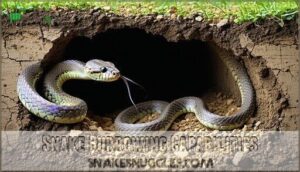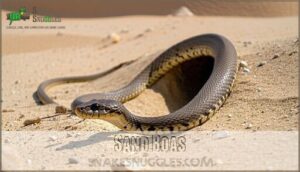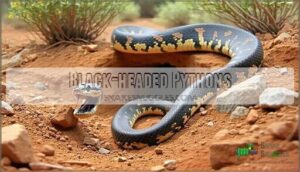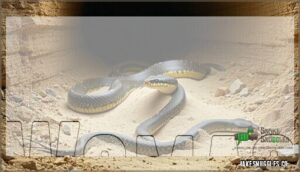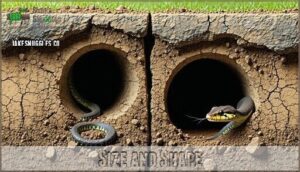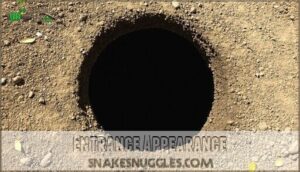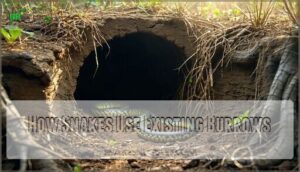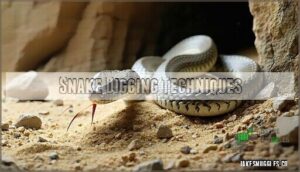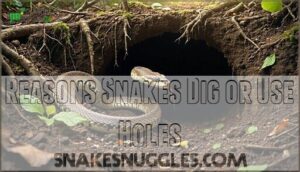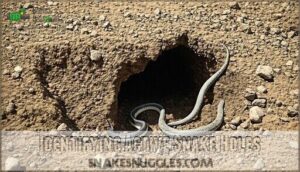This site is supported by our readers. We may earn a commission, at no cost to you, if you purchase through links.
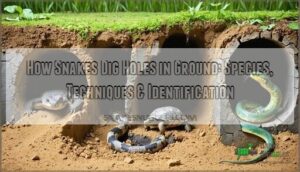
Only specialized species like sand boas and certain pythons can excavate their own burrows using powerful muscles to push through loose soil.
The majority of snakes simply move into existing holes made by rodents, turtles, or natural erosion.
When you wonder how snakes dig holes in ground, you’re usually looking at borrowed real estate rather than original construction.
These clever reptiles modify abandoned tunnels to fit their needs, creating perfect hideouts for temperature control and protection.
Knowing which species actually dig versus those that simply squat can help you identify what’s living in your yard’s mysterious holes, and understand the concept of opportunistic renters and how they utilize existing holes.
Table Of Contents
- Key Takeaways
- How Snakes Dig Holes in Ground?
- Snake Burrowing Capabilities
- Types of Snakes That Dig Holes
- Characteristics of Snake Holes
- How Snakes Use Existing Burrows
- Snake Digging Techniques
- Reasons Snakes Dig or Use Holes
- Identifying Active Snake Holes
- Frequently Asked Questions (FAQs)
- How do I know if I have a snake den in my yard?
- How do you tell the difference between a snake hole and a squirrel hole?
- What do snake nests look like?
- Do snakes return to the same hole?
- How does a snake make a hole in the ground?
- How can you tell a snake hole?
- How to get rid of a snake den in your yard?
- How deep do snakes burrow?
- Do snakes make holes in the ground?
- How does a snake dig a hole?
- Conclusion
Key Takeaways
- Most snakes don’t actually dig their own holes – You’re looking at opportunistic renters who move into existing burrows made by rodents, turtles, or other animals rather than construction crews breaking new ground.
- Only specialized species like sand boas and certain pythons can excavate burrows – These snakes have developed unique adaptations like wedge-shaped heads and powerful muscles to push through loose soil and sand.
- You can identify active snake holes by looking for clean, circular openings 2-4 inches wide – They’ll be free from debris and spider webs, with fresh tracks, shed skins, and dark droppings with white caps nearby.
- Snakes use holes for three main survival purposes – You’ll find they’re seeking protection from predators, regulating their body temperature, and setting up strategic hunting ambushes for unsuspecting prey.
How Snakes Dig Holes in Ground?
Here’s the reality about snake excavation: most snakes don’t actually dig their own holes.
They’re masters at repurposing existing burrows from rodents, turtles, and other creatures. However, some species do engage in burrow creation through snake digging techniques like pushing loose soil with their snouts.
Snakes are nature’s ultimate home renovators—they prefer moving into ready-made burrows over breaking ground themselves.
This snake burrowing behavior challenges common burrowing myths about these adaptable reptiles. They often seek snug retreats with small entrances.
Snake Burrowing Capabilities
Not all snakes possess the same burrowing adaptations for underground excavation. While some species excel at burrow creation through specialized snake digging techniques, others rely on opportunistic methods.
Soil preferences vary dramatically among species, with some thriving in loose sand while others prefer compact earth. Most snakes utilize existing holes rather than creating new ones, demonstrating efficient snake burrowing behavior that conserves energy.
The snake burrowing process involves specific excavation techniques and snake digging adaptations that differ by species. Understanding these snake burrowing methods helps you identify which snakes might inhabit your area.
As ecosystem engineers, burrowing snakes improve soil aeration and drainage.
Burrowing benefits include:
- Protection from deadly predators lurking above ground
- Escape from scorching heat and freezing temperatures
- Ambush opportunities for unsuspecting prey
- Safe shelter during vulnerable molting periods
- Energy conservation during winter brumation
Types of Snakes That Dig Holes
You’ll find that only certain snake species actively dig their own burrows, with sand boas, black-headed pythons, and womas being the most skilled excavators in the reptile world.
These specialized snakes have developed unique physical adaptations and techniques that allow them to create underground shelters in loose soil, sand, and similar substrates, making them expert excavators.
Sand Boas
Sand boas’ burrowing adaptations make them nature’s underground specialists.
These compact constrictors, reaching four feet maximum, possess wedge-shaped heads perfect for snake digging through loose substrates.
Their smooth scales reduce friction while tunneling, and their habitat preference for sandy environments showcases unique behaviors.
Unlike surface dwellers, sand boas create snake burrows for ambush hunting, emerging only when prey approaches their concealed positions.
These snakes, like others, exhibit adaptations for underground life such as small heads and tiny eyes.
Black-headed Pythons
While sand boas excel in loose substrates, blackheaded pythons showcase different burrowing techniques.
These Australian natives use powerful bodies to excavate snake burrows in rocky soil. Their unique adaptations include reinforced skulls for digging and habitat preferences for arid regions.
Snake digging capabilities include:
- Creating escape tunnels in loose soil
- Excavating hunting ambush points
- Sharing snake burrowing sites with other species
Womas
Australian woma pythons are skilled excavators that create elaborate underground tunnels in sandy soils.
These five-foot reptiles demonstrate remarkable snake burrowing abilities, constructing complex snake habitat systems.
You’ll discover their snake tunnel formation skills rival other species, as they’re masters of snake earth moving.
Watch for shed skins and droppings indicating active woma habitat construction in loose substrates.
Characteristics of Snake Holes
When you’re trying to spot a snake hole in your yard, you’ll notice these openings are typically circular, measuring 2-4 inches in diameter, and appear surprisingly clean without the usual debris or spider webs you’d find around other animal burrows.
You can identify them by their smooth, round entrances that often cluster together in grassy areas, with small dirt mounds nearby created by the snake’s movement in and out of the burrow, which can be a key indicator of a snake’s presence.
Size and Shape
You’ll find snake holes aren’t one-size-fits-all in terms of hole dimensions and entrance shape.
These underground hideouts show remarkable diameter variation and burrow depth differences based on the occupant’s size and snake digging skills. Snakes often create burrows to seek shelter from predators.
Here’s what to expect:
- Small holes measure 2-4 inches across, perfect for garter snakes and their earth manipulation needs
- Medium burrows reach 4-6 inches in diameter, accommodating larger species’ tunnel formation requirements
- Camouflage factors often make entrances appear oval or round, depending on snake burrowing habits and soil conditions
Location
Beyond their size, you’ll find snake holes in specific Habitat Types that meet their survival needs.
These underground tunnels appear in both Urban Areas and Rural Settings, often showing Hole Clustering patterns where multiple burrows exist nearby.
| Environment | Common Locations |
|---|---|
| Residential | Garden beds, foundation cracks |
| Natural | Root systems, rock formations |
| Mixed terrain | Vegetation edges, water sources |
Ground Cover and soil displacement indicate active snake burrowing beneath.
Identifying them involves looking for circular openings in soft ground.
Entrance Appearance
Snake hole entrance appearance offers clear identification clues when you know what to look for.
These openings reveal distinct characteristics that set them apart from other animal burrows.
- Hole Shape: Entrances appear perfectly circular, measuring 2-4 inches in diameter with smooth, well-defined edges
- Entrance Size: Larger species create openings up to 6 inches wide, while smaller snakes use narrower passages
- Debris Absence: Clean entrances lack leaves, twigs, or accumulated materials that typically clog unused burrows
- Webbing Absence: Spider webs don’t form across active snake hole entrance appearance, indicating regular use
How Snakes Use Existing Burrows
You’ll find that most snakes don’t actually dig their own holes, but instead take advantage of burrows already created by rodents, turtles, and other small animals.
Most snakes are clever opportunists, preferring to move into ready-made homes rather than breaking ground themselves.
These ready-made underground homes save snakes energy while providing the perfect shelter for protection, temperature control, and hunting opportunities.
Rodent Holes
Most snakes don’t dig their own homes but instead take advantage of rodent holes already carved into the ground.
These existing burrows provide perfect shelter without the energy cost of excavation.
Here’s how snakes use rodent holes:
- Hole Occupants – Gopher snakes and black racers often move into abandoned mouse or rat tunnels
- Snake Predation – Some species hunt the original rodent inhabitants within their own burrows
- Burrow Competition – Multiple animal species may compete for prime underground real estate
Turtle Burrows
While rodents create smaller tunnels, turtle burrows offer snakes spacious underground accommodations.
Gopher tortoises dig extensive tunnel networks up to ten feet long, creating prime snake habitat construction opportunities.
These shared spaces demonstrate remarkable burrow ecosystem dynamics, where species sharing benefits both animals through burrow defense cooperation.
| Turtle Burrow Feature | Snake Benefit |
|---|---|
| 10-foot tunnel length | Extended snake underground tunnels |
| 2-foot depth | Temperature regulation space |
| Wide entrance | Easy snake den creation access |
| Stable walls | Secure nesting impact protection |
| Multiple chambers | Burrow overlap hunting zones |
The table highlights the key features of turtle burrows and their corresponding benefits to snakes, showcasing a unique example of symbiotic relationship in the animal kingdom.
Frog Habitats
Wetland environments provide prime real estate for snake habitat construction, where amphibian biodiversity creates perfect underground tunnels.
You’ll find semiaquatic species like water snakes and crayfish snakes taking advantage of frog habitats for snake den creation and soil displacement activities.
Here’s what makes these spots attractive:
- Moisture retention – Frog habitats maintain consistent humidity levels
- Prey availability – Abundant amphibians support snake diet requirements
- Natural concealment – Wetland vegetation provides excellent cover
Snake Digging Techniques
You’ll discover that snakes use three main techniques to create or access underground spaces, each adapted to different soil types and environmental conditions.
These methods include burrowing through loose soil with their muscular bodies, submersing themselves in sand using specialized scales, and concealing themselves beneath leaf litter through careful manipulation of surface materials.
Loose Soil Burrowing
Three key factors determine successful loose soil burrowing: soil composition, excavation methods, and tunnel structure.
You’ll notice snakes prefer soft substrates where their bodies can displace earth efficiently.
Their specialized burrowing techniques create stable tunnels for predator avoidance.
| Burrowing Factor | Snake Adaptation |
|---|---|
| Soil Composition | Targets soft, loose substrates |
| Excavation Methods | Uses body undulation for earth manipulation |
| Tunnel Structure | Creates compact, stable burrows |
| Burrow Stability | Maintains structural integrity through revisits |
| Snake Soil Displacement | Efficient movement through loose soil |
Sand Submersion
When you observe sand-dwelling species, you’ll notice their remarkable sand submersion abilities.
These burrowing snakes use specialized burrowing adaptations to disappear beneath loose substrates within seconds.
Their snake soil displacement techniques create temporary shelters despite substrate stability challenges.
- Sand camouflage – Bodies blend seamlessly with surrounding grains
- Desert thermoregulation – Cool temperatures maintained underground
- Predator avoidance – Quick escape from surface threats
- Snake tunnel excavation – Efficient snake earth manipulation creates secure hideouts
Leaf Litter Concealment
While sand offers some species cover, leaf litter provides year-round snake camouflage for many species.
You’ll find burrowing snakes using decaying leaves as natural snake shelter, creating shallow depressions rather than deep snake holes.
This technique offers excellent Camouflage Effectiveness and Predatory Advantage through Microclimate Influence.
Snakes use disruptive patterns for effective camouflage strategies to avoid predators.
| Concealment Factor | Effectiveness |
|---|---|
| Camouflage Effectiveness | Excellent blending |
| Predatory Advantage | Ambush opportunities |
| Habitat Specificity | Forest floors |
| Seasonal Variation | Year-round availability |
| Microclimate Influence | Temperature regulation |
Reasons Snakes Dig or Use Holes
You’ll find that snakes use holes for three main survival purposes: escaping predators, controlling their body temperature, and setting up hunting ambushes.
These underground spaces work like nature’s multipurpose tool, giving snakes the protection, comfort, and strategic advantage they need to thrive in their environments, which is their key to survival.
Protection From Predators
Snakes rely on underground shelter as their primary defense mechanism against aerial predators like hawks and owls.
These burrows offer essential camouflage strategies that keep them hidden from view.
Here’s how snake holes provide effective predator avoidance:
- Complete concealment from birds of prey scanning from above
- Secure escape routes when threatened by ground predators
- Reduced vulnerability during vulnerable periods like shedding
Temperature Regulation
Beyond predator protection, you’ll find snakes use holes for temperature regulation through ectothermic regulation.
These underground shelters create a stable burrow microclimate with natural thermal gradients.
During winter’s brumation behavior, burrowing becomes critical for seasonal adaptation.
Snake holes provide cooling relief from summer heat and warming protection during cold snaps, helping maintain ideal body temperatures for snake thermoregulation.
Hunting and Ambush
While temperature control keeps snakes comfortable, hunting and ambush tactics make snake holes deadly traps for unsuspecting prey.
You’ll find snakes positioning themselves strategically, waiting for the perfect moment to strike with lightning speed.
- Ambush tactics involve patient waiting near hole entrances for passing rodents
- Prey selection focuses on animals that frequent the same burrow systems
- Strike speed increases dramatically when launching from concealed positions
- Sensory adaptations help detect vibrations from approaching snake food sources
- Predator protection allows focused hunting without constant vigilance
Identifying Active Snake Holes
You can determine if a snake hole is actively used by looking for three key signs: fresh tracks in the surrounding soil, shed snake skins near the entrance, and dark brown fecal matter with white caps.
These indicators, especially when found together, confirm that a snake has recently occupied the burrow and may still be using it for shelter or hunting.
Fresh Tracks
Track identification around snake holes reveals recent activity through distinctive crawl patterns in disturbed soil.
You’ll spot wavy, S-shaped trails leading to burrow entrances, especially after rain when tracks remain visible longer.
Footprint analysis isn’t possible since snakes lack feet, but their activity timing creates fresh soil disturbance patterns.
These serpentine impressions help confirm active snake hole identification.
Evidence can be found in snake hole tracks.
Shed Skins
Discovering shed skins around a hole confirms active snake occupancy.
These translucent casings reveal vital details about your underground visitors.
Here’s your identification guide:
- Shedding Frequency: Fresh skins indicate recent activity, as snakes shed multiple times yearly
- Skin Composition: Complete sheds show size and species patterns
- Health Indicators: Clear, intact skins suggest healthy snake populations using these snake holes regularly
Fecal Matter
Snake feces near holes tell a fascinating story about recent activity.
These thick, dark brown deposits with white chalky caps reveal vital diet indicators and health analysis clues.
Fresh snake droppings suggest active use, while dried specimens indicate older activity.
You’ll notice scent marking properties that help snakes communicate territory.
The decomposition process varies with weather conditions, affecting identification timing.
Look for these snake signs alongside snake tracks around snake holes in ground.
Snake feces identification becomes easier when you understand that larger snakes produce proportionally bigger droppings, helping determine species size.
This understanding, combined with the observation of snake tracks and snake holes, aids in a more accurate analysis of snake activity.
Frequently Asked Questions (FAQs)
How do I know if I have a snake den in my yard?
Don’t panic if you spot mysterious holes – they’re likely hiding spots, not permanent dens.
Look for clustered circular openings, shed skins, dark droppings with white caps, and clean entrances without spider webs.
How do you tell the difference between a snake hole and a squirrel hole?
Check the hole’s entrance for debris and spider webs – squirrel holes contain leaves, twigs, and nesting materials, while snake holes stay clean.
Squirrel holes also show fresh digging marks and scattered soil around the opening.
What do snake nests look like?
Like finding needles in nature’s haystack, you won’t spot traditional snake nests since snakes don’t build them.
Instead, they’ll lay eggs in abandoned burrows, rotting logs, or leaf piles, using existing shelters rather than constructing homes, which is a key aspect of their behavior, particularly in how they utilize abandoned spaces.
Do snakes return to the same hole?
Yes, snakes often return to familiar holes they’ve used before, especially if the location provides good shelter and hunting opportunities.
They’ll remember safe spots and revisit them seasonally or when seeking protection.
How does a snake make a hole in the ground?
Like nature’s patient architect, snakes don’t actually dig holes themselves.
Instead, they’re opportunistic tenants who move into existing burrows created by rodents, using their bodies to widen these ready-made underground apartments, acting like opportunistic tenants in these ready-made underground spaces.
How can you tell a snake hole?
Snake holes appear as clean, circular openings about 2-4 inches wide, free from debris and spider webs.
You’ll spot small dirt mounds nearby, shed skins, and dark droppings with white caps around the entrance, which can be considered complete concepts for identifying snake holes.
How to get rid of a snake den in your yard?
While it’s tempting to think you’ve discovered a snake metropolis, most "dens" are actually temporary shelters.
Fill holes with dirt, remove food sources like rodents, and trim vegetation to discourage snakes from settling permanently.
How deep do snakes burrow?
Most snakes burrow just a few inches deep for daily shelter.
But they’ll dig deeper during winter brumation—sometimes several feet down—to escape freezing temperatures and find stable ground below the frost line.
Do snakes make holes in the ground?
Most snakes don’t actually create holes themselves.
They’re opportunistic tenants who move into existing burrows made by rodents, insects, or other animals.
However, you’ll find a few species that can dig their own underground hideouts, making them distinct from the majority that do not create their own holes, instead being opportunistic tenants.
How does a snake dig a hole?
Most snakes don’t actually dig holes themselves.
They’re smart enough to use existing burrows created by rodents, insects, or other animals, then modify these ready-made spaces to fit their needs perfectly.
Conclusion
Remarkably, less than 15% of snake species actually excavate their own burrows, with most preferring ready-made accommodations.
Understanding how snakes dig holes in ground reveals fascinating adaptations and behaviors that help you identify yard visitors.
Whether you’re observing genuine diggers like sand boas or opportunistic renters using rodent tunnels, recognizing these patterns enhances your wildlife knowledge.
Next time you spot mysterious holes, you’ll know whether you’re looking at snake construction or simply borrowed real estate in nature’s housing market, which is part of their natural behavior.
- https://anatomypubs.onlinelibrary.wiley.com/doi/10.1002/ar.24686
- https://thebackyardpros.com/identifying-snake-holes-in-the-yard/
- https://a-z-animals.com/animals/snake/snake-facts/snakes-that-burrow-underground
- https://mynatureguard.com/blog/what-does-a-snake-hole-look-like-in-a-yard
- https://www.trutechinc.com/florida-snake-holes

